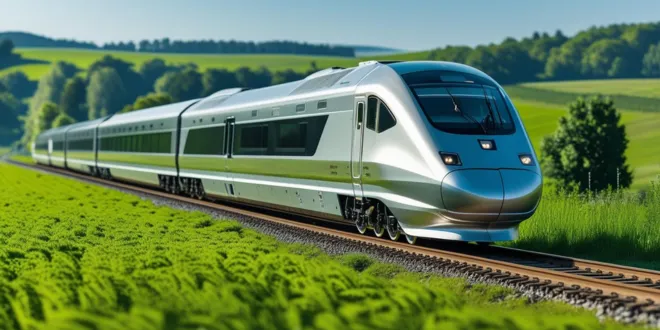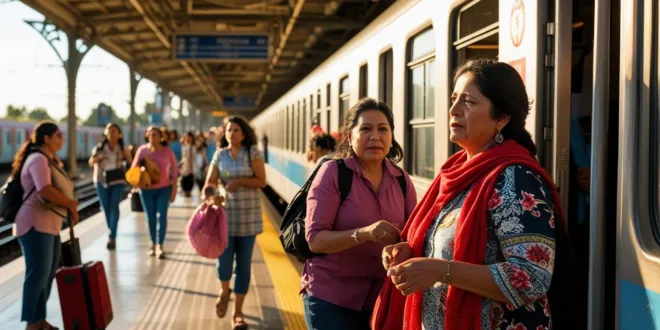Getting Around Germany is efficient, reliable, and surprisingly easy—thanks largely to its world-class public transportation system. At the heart of it all is Deutsche Bahn (DB), the national railway company that connects cities, towns, and rural areas with a seamless network of trains and regional transit.
Whether you’re a tourist exploring Berlin, Munich, and Hamburg, or an expat commuting daily, Why Deutsche Bahn (DB) is the Best Way to Travel in Germany quickly becomes clear: punctual service, extensive coverage, and eco-friendly options make DB the top choice for both short and long-distance journeys.
Germany’s rail system features a variety of train types, each serving a different purpose. Understanding the Types of Trains in Germany—from high-speed ICE (InterCity Express) trains to regional RE, RB, and urban S-Bahn services—is essential for planning efficient trips. With the right knowledge, you can avoid confusion and save time and money.
Knowing How to Buy DB Train Tickets is another key step. Tickets can be purchased online via the DB website, through the user-friendly DB Navigator app, or at station ticket machines. Options range from discounted saver fares to flexible flex tickets, and new passes like the Deutschlandticket offer unlimited regional travel for just €49/month.
Finally, mastering how to Navigate German Train Stations—especially major hubs like Frankfurt Hauptbahnhof or Berlin Hbf—ensures a stress-free experience. With clear signage, real-time departure boards, and helpful staff, even first-time travelers can move confidently through Germany’s transport network.

Getting Around Germany
Germany offers one of the most efficient, punctual, and well-connected public transportation systems in the world. Whether you’re traveling between major cities like Berlin, Munich, and Hamburg, or exploring smaller towns, public transit makes it easy and stress-free.
The backbone of this network is Deutsche Bahn (DB), which operates high-speed trains, regional services, and integrated local transit. With frequent departures, real-time updates, and eco-friendly options, DB ensures reliable travel across the country.
Beyond trains, Germany’s urban areas are served by U-Bahn (subway), S-Bahn (commuter rail), trams, and buses, all following coordinated schedules. Public transport is also safe, accessible, and increasingly affordable with options like the €49 Deutschlandticket. Whether you’re a tourist or a resident, navigating Germany without a car is not only possible — it’s often the best choice.
Why Deutsche Bahn (DB) is the Best Way to Travel in Germany
Deutsche Bahn (DB) is the most convenient and reliable way to travel across Germany. It connects over 5,000 stations nationwide, offering fast, frequent, and comfortable journeys.
DB’s high-speed ICE trains can reach 300 km/h, making intercity travel quicker than driving or flying when you factor in airport security and transfers. With seamless connections to regional trains, buses, and city transit, DB provides door-to-door efficiency. The system is safe, well-maintained, and increasingly sustainable, with many trains powered by renewable energy.
Digital tools like the DB Navigator app make planning, booking, and tracking trains effortless. Unlike driving, you avoid parking fees, traffic, and navigation stress. For tourists, DB offers scenic routes and city-center-to-city-center convenience.
Whether you’re commuting or touring, DB saves time, reduces costs, and offers a smooth travel experience — making it the best way to explore Germany.
Types of Trains in Germany
- ICE (InterCity Express)
- IC (InterCity)
- EC (EuroCity)
- RE (Regional-Express)
- RB (Regionalbahn)
- S-Bahn
- U-Bahn
ICE (InterCity Express)
Germany’s fastest train, connects major cities at speeds up to 300 km/h. Ideal for long-distance travel.
IC (InterCity)
Slightly slower than ICE, but still connects major cities with fewer stops than regional trains.
EC (EuroCity)
International version of IC, connects Germany with neighboring countries.
RE (Regional-Express)
Regional train with limited stops, links cities and towns within a state.
RB (Regionalbahn)
Slower regional train, stops at nearly every station.
S-Bahn
Urban commuter rail serving cities and suburbs. Integrated with local transit.
U-Bahn
Underground metro system within major cities (not operated by DB).

How to Buy DB Train Tickets
- Online: Visit bahn.de or use the DB Navigator app to book and store e-tickets.
- At the Station: Use automated ticket machines (available in English) or go to the DB ticket counter.
- Ticket Types: Choose from Sparpreis (cheap, non-refundable), Flexpreis (flexible), or group tickets.
- Deutschlandticket: €49/month for unlimited regional travel (valid on RE, RB, S-Bahn, buses, trams).
- Payment: Cards and mobile payments are widely accepted.
- E-Tickets: Receive QR code via email or in the app — no need to print.
- Validation: Only paper tickets from machines without date/time must be stamped before travel.
How to Navigate German Train Stations
German train stations, especially major hubs like Frankfurt Hbf, Berlin Hbf, or Munich Hbf, are large but well-organized. Clear signage in German and English directs you to platforms (called “Gleis”), ticket machines, restrooms, and exits.
Departure boards display real-time train info, including platform numbers, delays, and cancellations. Arrive at least 15–20 minutes before departure to find your platform.
Platforms are long, so follow signs for your train’s car numbers (marked on the platform floor). Stations often have shops, cafes, and lockers.
Use the DB Navigator app for indoor maps and live updates. S-Bahn and regional trains usually depart from lower-level platforms, while ICE/IC trains use main-level tracks. With a bit of orientation, even first-time visitors can confidently navigate Germany’s efficient and user-friendly rail hubs.

Conclusion
Navigating Germany has never been easier, thanks to one of the most efficient and well-connected public transportation systems in Europe.
At the core of this network is Deutsche Bahn (DB), which continues to prove why Deutsche Bahn (DB) is the best way to travel in Germany. With its punctuality, extensive reach, and integration with local transit, DB offers a stress-free alternative to driving—especially in a country where sustainability and convenience go hand in hand.
Understanding the Types of Trains in Germany—from the high-speed ICE trains linking major cities to regional RE, RB, and urban S-Bahn services—is essential for making smart travel choices. Whether you’re planning a quick commute or a cross-country adventure, knowing the differences helps you save time and money.
Equally important is knowing How to Buy DB Train Tickets. With multiple options online, via the DB Navigator app, or at station kiosks, purchasing tickets is simple and accessible. From discounted Sparpreis fares to the affordable Deutschlandticket, there’s a solution for every type of traveler.
Finally, learning how to Navigate German Train Stations—such as Berlin Hauptbahnhof or Munich Hbf—ensures smooth transfers and confident travel. Clear signage, digital departure boards, and helpful staff make even the busiest hubs easy to manage.
By mastering these elements, you’ll unlock the full freedom of movement across Germany—efficiently, affordably, and comfortably.
Frequently Asked Questions
1. Is public transport in Germany good?
Yes, Germany has one of the best public transport systems in Europe. Trains, trams, buses, and subways are punctual, safe, and well-connected. Deutsche Bahn operates long-distance services, while local transit handles urban and regional routes.
Whether you’re in Berlin or a small village, reliable options are available for commuters and travelers alike.
2. How do I use public transport in Germany?
Using public transport in Germany is easy. Buy a ticket for trains, buses, or subways via app, machine, or online. Validate paper tickets before boarding (except DB e-tickets). Follow signs for platforms and routes. Use the DB Navigator app for real-time schedules. Always keep your ticket handy for inspections during your journey.
3. How do I buy a train ticket in Germany?
You can buy DB train tickets online at bahn.de, via the DB Navigator app, or at station ticket machines. Options include Sparpreis (discounted), Flexpreis (flexible), and group tickets. E-tickets are emailed or stored in the app. Always check departure times and platform info before traveling.
4. Can tourists use the Deutschlandticket?
Yes, tourists can use the Deutschlandticket. Priced at €49/month, it allows unlimited travel on local and regional transport, including DB regional trains, S-Bahn, U-Bahn, trams, and buses. It’s available as a digital or physical ticket. However, it’s not valid on long-distance trains like ICE, IC, or EC.
5. What is the difference between ICE, IC, and RE trains in Germany?
ICE (InterCity Express) is Germany’s high-speed train for long distances. IC (InterCity) is slightly slower, connects major cities, and is often cheaper. RE (Regional-Express) serves regional routes with more stops. ICE and IC require seat reservations (optional on IC), while RE is for local travel and not valid with long-distance tickets.
6. Is Deutsche Bahn reliable?
Deutsche Bahn is generally reliable, especially for long-distance ICE and IC trains. However, delays and cancellations can occur due to weather, strikes, or infrastructure issues. Regional services may be less punctual. Always check real-time updates via the DB Navigator app and allow extra time during peak or strike periods.
7. How do I get from the airport to the city in Germany?
Most German airports have direct train or S-Bahn connections to the city center. For example, Frankfurt Airport has an ICE station, while Munich Airport is linked by S-Bahn and regional trains. Tickets can be bought at machines or online. The journey usually takes 10–30 minutes, depending on the city.
8. Do I need to validate my train ticket in Germany?
You only need to validate paper tickets bought from machines if they don’t have a printed time/date. Tickets from the DB app, website, or staff are already valid. Unvalidated paper tickets can lead to fines. Never validate e-tickets — just show them on your phone during inspections.
9. Can I use my phone as a train ticket in Germany?
Yes, you can use your phone as a train ticket. When you buy tickets via the DB Navigator app or website, you receive a mobile ticket (QR code). Simply open it on your phone and show it to inspectors. Ensure your phone is charged and the QR code is clearly visible.
10. How early should I arrive at a German train station?
Arrive at least 10–15 minutes early for regional trains and 20–30 minutes early for long-distance or ICE trains, especially at major stations like Berlin Hbf or Frankfurt Hbf. This gives you time to find platforms, navigate large stations, and board stress-free. Check platform changes on departure boards.
